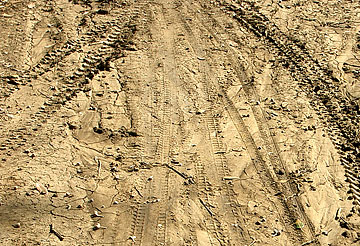- Home
- Learn about salinity
- Get to know your site
- Design a landscape
- Solve a problem
- Other information
Salinity Management Guide

Assessing the physical characteristics of soil
Determining the degree of compaction
The continued puddling of water in a landscape's flat areas, patches of bare soil where no plants grow, and places on the landscape that require an inordinate amount of effort to penetrate with a shovel may be signs of compacted soil.
To further determine whether an area is compacted, dig a hole one to two feet deep and then probe a side wall of the hole with a metal rod approximately 1/4 inch in diameter and about 18 inches long. Start at the surface and progress to the bottom of the hole. If a particular layer of soil exposed in the side wall of the hole offers a lot of resistance to probing or if the roots of any plants appear flattened or stubby or are growing laterally in a layer, that could mean the layer of soil is compacted.
To more accurately measure a soil's compaction, collect a small, undisturbed core of the soil and send it to a commercial laboratory for analysis. To collect such a core of soil, start by using a hammer or mallet to drive a sampling can of known volume evenly into the soil. Often it's helpful to place a block of wood across the end of the can and hammer the wood. Drive the can all the way into the soil if you can, filling it with relatively undisturbed soil.
Next, extract the soil-filled can with a trowel or shovel, being careful not to disturb the can's contents.
In exactly the same manner, collect another core of soil from a nearby area that seems uncompacted.
Bulk densities for various types of soil, compared
| Texture of soil | Ideal bulk density (g/cm3) | Bulk density of soil that’s restrictive to roots, possibly as a result of compaction (g/cm3) |
|---|---|---|
| Sand, Loamy sand | < 1.60 | > 1.80 |
| Loam, Sandy loam | < 1.40 | > 1.80 |
| Loam, Sandy clay loam | < 1.40 | > 1.75 |
| Silt, Silty loam | < 1.30 | > 1.75 |
| Silty Clay loam | < 1.40 | > 1.65 |
| Sandy clay, Silty clay | < 1.10 | > 1.58 |
| Clay | < 1.10 | > 1.47 |
Adapted from Soil Quality Test Kit Guide, published by the U. S. Department of Agriculture (1999).
Submit both samples to a laboratory to analyze for what's known as bulk density — the weight per unit volume of an (undisturbed) sample of soil that includes both solids and pore space. Compaction reduces the volume of pore space, increasing the density of a soil. Thus, if the sample from the area you suspect is compacted has a higher bulk density than the other sample, then the soil from the former area may indeed be compacted.
| « Previous page | Next page » |